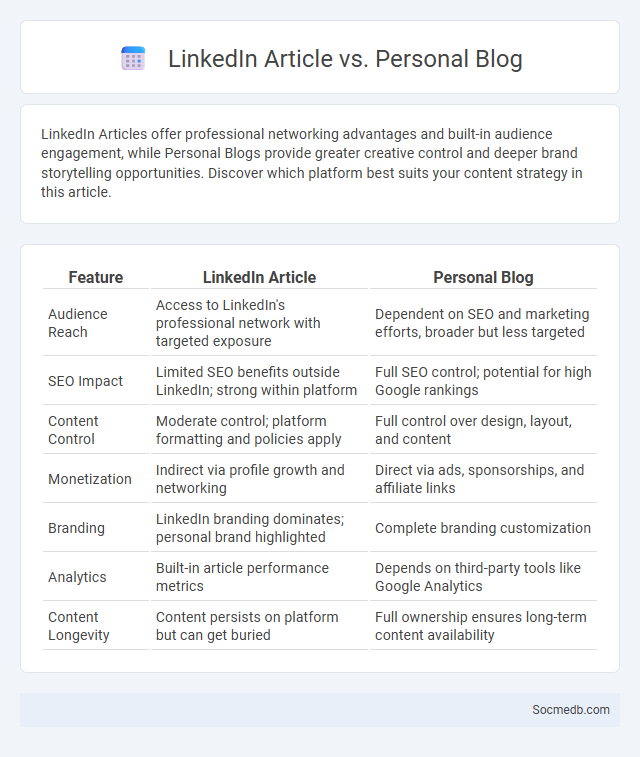
Photo illustration: LinkedIn Article vs Personal Blog
LinkedIn Articles offer professional networking advantages and built-in audience engagement, while Personal Blogs provide greater creative control and deeper brand storytelling opportunities. Discover which platform best suits your content strategy in this article.
Table of Comparison
| Feature | LinkedIn Article | Personal Blog |
|---|---|---|
| Audience Reach | Access to LinkedIn's professional network with targeted exposure | Dependent on SEO and marketing efforts, broader but less targeted |
| SEO Impact | Limited SEO benefits outside LinkedIn; strong within platform | Full SEO control; potential for high Google rankings |
| Content Control | Moderate control; platform formatting and policies apply | Full control over design, layout, and content |
| Monetization | Indirect via profile growth and networking | Direct via ads, sponsorships, and affiliate links |
| Branding | LinkedIn branding dominates; personal brand highlighted | Complete branding customization |
| Analytics | Built-in article performance metrics | Depends on third-party tools like Google Analytics |
| Content Longevity | Content persists on platform but can get buried | Full ownership ensures long-term content availability |
Understanding LinkedIn Articles
LinkedIn Articles provide a powerful platform for professionals to share in-depth insights and industry knowledge, enhancing thought leadership and audience engagement. These long-form posts support rich media such as images, videos, and hyperlinks, improving readability and SEO performance within LinkedIn's algorithm. Optimizing content with relevant keywords, clear structure, and actionable insights increases visibility, driving traffic and fostering meaningful professional connections.
What Is a Personal Blog?
A personal blog is an online platform where individuals share their thoughts, experiences, and opinions on various topics, often reflecting their unique personality and interests. It serves as a space for self-expression and storytelling, allowing users to connect with audiences through authentic, personalized content. Popular blogging platforms like WordPress, Blogger, and Medium are commonly used to create and manage personal blogs, enhancing visibility and engagement on social media.
Defining Traditional Articles
Traditional articles on social media platforms typically consist of well-structured, long-form content that provides in-depth analysis, comprehensive information, and expert insights. These articles prioritize thorough research, credible sources, and clear formatting to enhance reader engagement and trust. Unlike brief posts or viral content, traditional articles emphasize quality and detailed storytelling to establish authority in a particular niche.
Audience Reach and Engagement
Maximizing audience reach on social media platforms requires strategic content distribution across channels like Facebook, Instagram, and TikTok, targeting demographics based on interests and behavior. Engagement rates are boosted through interactive content such as polls, videos, and live sessions that encourage comments, shares, and likes, fostering a loyal community around your brand. Analyzing metrics like impressions, click-through rates, and follower growth enables you to refine campaigns and enhance your social media presence effectively.
Content Ownership and Control
Social media platforms grant users the ability to create and share content while often retaining certain rights or licenses to that content, affecting ownership and control. Users must carefully review platform terms of service, as many agreements give companies broad rights to use, distribute, or modify user-generated content. Understanding content ownership policies is crucial for protecting intellectual property and maintaining control over how content is shared and monetized.
SEO and Discoverability
Optimizing social media content for SEO enhances discoverability by incorporating relevant keywords, hashtags, and geo-tags that align with search intent and trending topics. Engaging multimedia content, such as videos and infographics, boosts user interaction metrics, which positively influence algorithm ranking and visibility on platforms like Instagram, Twitter, and LinkedIn. Consistent posting schedules combined with strategic backlinking from reputable sources increase domain authority and drive organic traffic through improved search engine indexing.
Platform Features and Limitations
Social media platforms offer diverse features such as real-time messaging, multimedia sharing, customizable profiles, and algorithm-driven content feeds that enhance user engagement and connectivity. However, these platforms face limitations including privacy concerns, content moderation challenges, algorithmic bias, and data security risks. Understanding these features and constraints is crucial for optimizing user experience while mitigating potential negative impacts.
Professional vs. Personal Branding
Social media platforms serve distinct purposes for professional and personal branding, with LinkedIn emphasizing career achievements and industry expertise, while Instagram and Facebook highlight personal interests and lifestyle. You can strategically curate content to enhance your professional image by sharing relevant work experiences, endorsements, and industry insights that resonate with prospective employers or clients. Balancing authenticity and professionalism on these platforms ensures your personal narrative supports and strengthens your overall brand identity.
Monetization Opportunities
Social media platforms offer diverse monetization opportunities, including sponsored content, affiliate marketing, and direct product sales, enabling creators to turn their online presence into a revenue stream. By leveraging data analytics and targeted advertising, you can optimize content for higher engagement and increased income potential. Influencer partnerships and subscription-based models further enhance your ability to capitalize on your audience's interests and loyalty.
Choosing the Best Platform for Your Goals
Choosing the best social media platform for your goals involves understanding the unique audience demographics and engagement styles of sites like Instagram, LinkedIn, and TikTok. Tailoring your content to fit the platform's strengths maximizes reach, whether targeting professionals on LinkedIn or younger users on TikTok. Analyzing your specific objectives and aligning them with each platform's features ensures your social media strategy drives meaningful results.
 socmedb.com
socmedb.com